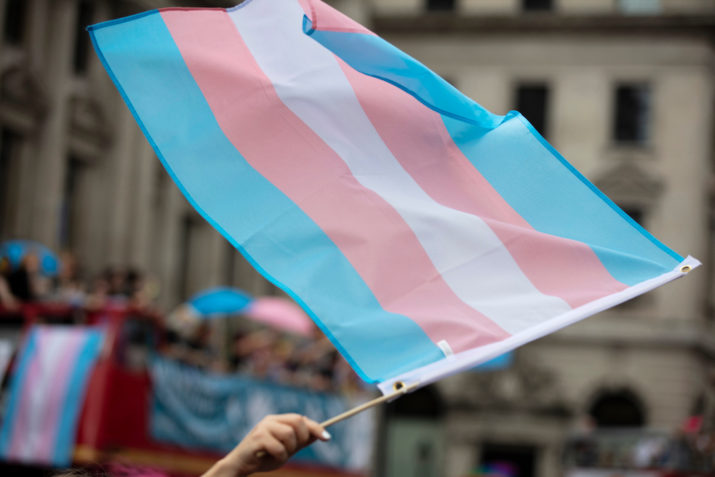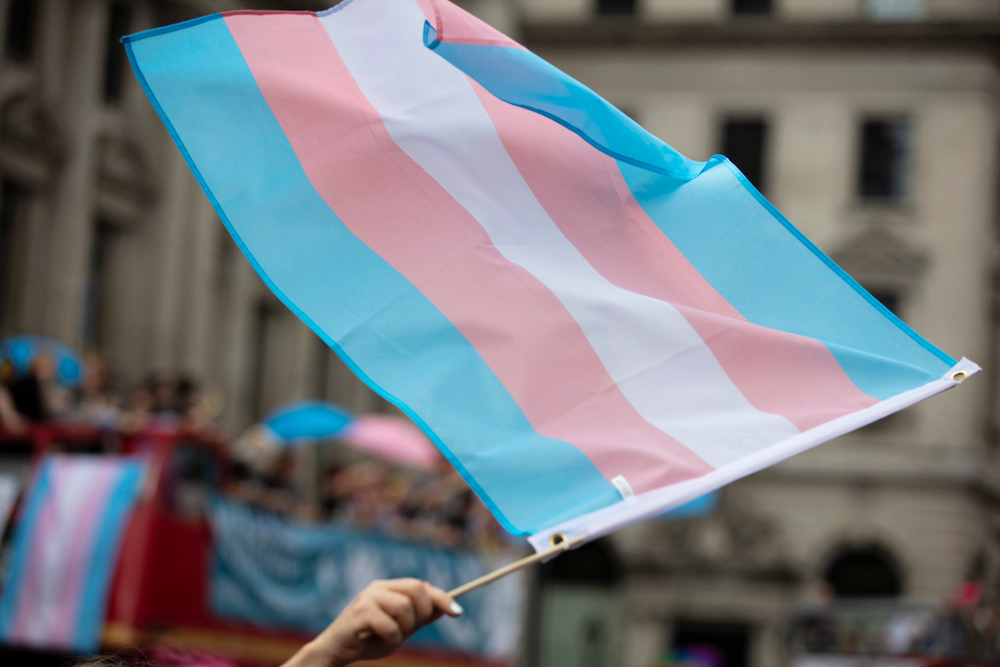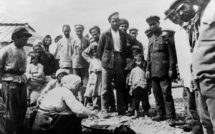
What’s in a Name?: Metadata, Digital Ethics, and the Making of a British Trans Archive

An introduction to our campus spotlight on the University of Washington.
On May 30, 1963, Katherine Jones, the tenant of a cheap one-room flat in London’s West End, was hauled before the Hampstead Magistrates Court on grounds that she “did unlawfully and knowingly permit [the premises] to be used for the purposes of habitual prostitution.”[1] It was a serious charge, with a high burden of proof, and as Jones’s case wound its way up to Britain’s Central Criminal Court it accumulated a long tail of evidence documenting her life in sometimes excruciating detail.[2] Jones was photographed, measured, and medically evaluated by officers of the court; her hairstyle and clothes were scrutinized, her prior convictions aired not just in court but in local newspapers all the way from Aberdeen to Singapore. Her doctor even testified regarding the gender-affirming hormone therapy that had placed her in, as he put it, “a transitional, or half-way state” between male and female. And, yet, despite the prosecution’s focus on the minutiae of Jones’s personal and sexual identity, when the National Archives catalogued her case file it did so in terms that rendered Jones herself almost invisible. Recording only her legal name and the charges against her, the file’s description bears no trace of Jones’s self-description as a woman—nor of the challenge she posed to the taxonomic foundations of the archive itself.
As a historian of sex and gender in mid-twentieth-century Britain, I routinely encounter this kind of bureaucratic erasure when I go looking for evidence of people like Katherine Jones. In the United Kingdom, as in most European states, legal sex is framed as binary and immutable: until 2004 trans Britons had no systematic way of changing their natal sex designation, and even today, nonbinary people and/or people who transition non-medically remain officially unseen by the state.[3] However, as Jones’s voluminous case file illustrates, the absence of policy language for describing gender variance in no way implies that gender-variant people are absent from the historical record. While selective preservation practices have certainly limited the evidence that survives, I argue that what K.J. Rawson calls “archival gaps” in trans historiography may reflect problems of discovery as well as retention, of metadata as well as data.[4] Trans stories may have been there all along, in other words—we just could not find them. And in this respect, the recent digital turn in archival practice has made new kinds of trans histories possible. Online catalogues and documents formatted via Optical Character Recognition (OCR) software allow historians to trawl a vast sea of data for relevant records, even as their main operating principle—the keyword query—sharpens longstanding interdisciplinary debates about how to name and classify gender-variant historical subjects.
At the core of these debates is the changing role of archival metadata, or information about the content, context, location, and attributes of historical documents. Initially, most major European repositories were organized with bureaucrats in mind: following the eighteenth-century principle of respect des fonds, they built collections around records with a common institutional origin and constructed a hierarchical system of reference codes to help archivists retrieve discrete items within those collections.[5] Fonds, thus, by design, tend to preserve the systems of metadata generated by the records’ creators. For instance, the information included in the catalogue entry for Katherine Jones’s file—name, charge, trial date, and a reference code situating the file within the collection of records (CRIM) from the Central Criminal Court—replicates the information used to cite court cases in judicial opinions, thus making it easier to retrieve her file for use as legal precedent.
However, as more and more archives migrate their paper catalogues online, the structural logic of fonds is becoming less and less hegemonic. While users can still “browse” the contents of fonds, series, and subcollections as units, they can also browse curated collections of records tailored to a specific theme: the National Archives website, for instance, now features a page of finding aids for “Sexuality and Gender Identity History.”[6] Catalogues that allow users to tag items with subject descriptors of their choosing (e.g. “transgender”) offer even more categorical flexibility. And keyword queries essentially create new subcollections whenever they are run, scanning an archive’s entire database for strings of characters that fit a user’s given parameters and returning results as a set of item-level references ranked alphabetically, or chronologically, or by “relevance.” The digitization of archival metadata, in sum, makes it easier for archive users to extract records from the institutional context in which they were created. It facilitates the kind of multisite, multimedia research that is vital in charting histories of statistically rare phenomena like gender transition. It ensures that descriptions of records need not, as Sonia Renade puts it, “be ‘frozen’ at the point of accession,” but may evolve to reflect the diverse ways historians read records against the grain to tell stories their creators might not have intended to tell.[7]
None of these e-discovery mechanisms, of course, will be unfamiliar to most scholars of European history. Indeed, search engines are all but inescapable in the first phases of historical projects, involved in everything from establishing timelines to setting travel itineraries. I dwell on them at length, then, less because they are novel or disruptive technologies than because they play a key intellectual role in defining the scope of a new British “trans archive.” Building on a still-dominant strand of mid-2000s information theory, I conceive of this archive as a virtual space, the “site of a deliberate project”—to borrow from Arjun Appadurai—that brings together diverse strands of public memory in order to resist the structural erasure of the trans past.[8] But while I believe this archive is politically and socially necessary, I also believe we must attend to, and carefully document, the conditions of its construction. Keywords and query syntax are as much an organizing principle as fonds: they determine not just which documents can be retrieved but also how those documents can be ordered and ranked in response to the needs of an imagined set of users. They, too, shape the kinds of stories a “trans archive” can tell.
Indeed, my decision to name this project as trans itself has ethical implications. As an English-speaking person who transitioned in the mid-2000s, I usually describe myself and the subject I study as transgender. This is as much about convenience as conviction: transgender is a recognizable, fairly politically-neutral term, and is the term most often used to group documents related to gender variance under subject tags or in exhibition web pages. As a scholar, however, I quickly realized that transgender had limited utility. Prior to 1975, the chronological endpoint of my project, the word was only in circulation within small American subcultures. Thus, when I searched for it in digital newspaper databases—the first type of archive I consulted—and filtered results by my project’s designated time frame, my search returned almost no hits. Subsequent searches for dated but still-current clinical terms like transvestite and transsexual proved little more fruitful outside of a slim subset of medical journals.[9] Choosing to reframe my topic as trans history then, was a way of extending my project beyond the clinical realm. I am interested in the processual aspect of gender variance—in people whose genders appear to be in motion—and trans suggested itself as a way of building an archive around that process rather than around my subjects’ assumed identities.
What followed this choice, over the course of the rest of my research years, was a long, slow process of gathering and winnowing sources. Because I set out looking for a broad cross-section of gender-variant expressions, I had to learn to navigate not just myriad online catalogue interfaces, but also a rich array of euphemisms, allusions, and structural silences woven into these catalogues’ descriptive conventions. Indeed, even tracing the story of a single individual often meant learning the lexicons of multiple repositories and record-creators, each of which classified the individual in a different way. My encounter with Katherine Jones, for instance, began with a headline in the Daily Mail Historical Archive: “Sex Change Man’s Plea,” it read, four words packing a one-two punch of misgendering and mawkish sentimentality.[10] In this case, though, I had known more or less what to expect. I had learned early on in my trawl through OCR-formatted newspapers that searching for “sex change” or “change of sex”—the quotation marks limiting returns only to the exact phrase—was far and away the most efficient means of finding traces of gender variance in the1960s tabloid press. And although I cringed whenever I typed them into a search bar, I kept on typing them, in part because tabloid articles often served as a starting point for forays into archives that were less willing to name gender variance explicitly.
This was the case when, knowing that the National Archives sometimes retained Central Criminal Court records, I attempted to track down documentary evidence of Jones. I had already run “sex change” and “change of sex” as queries in their online catalogue and knew that Jones’s file was not among the hundred-odd results. It was only months later—after I had worked out the name-and-charge descriptive formula of the Central Criminal Court collection—that I thought to search for her name directly, and, thanks to her unusual double-barreled legal surname, found her at once. From there, I was able to fill in more details of her history by matching the dates of police depositions to entries in the Magistrates Court registers held by the London Metropolitan Archives. And these three sets of sources, put together, gave me enough data to put Katherine Jones at the center of a dissertation chapter on trans community and urban networks in the 1960s. It was, in this sense, an example of exactly the kind of recontextualization that makes a “trans archive” possible. Although the records were created by hostile witnesses to serve the interests of a carceral state, they can nevertheless be read against the grain as a rich, if skewed, source of information about the lives of working-class trans people in an era when few trans people left behind archives of their own.
However, my work in building Katherine Jones’s virtual “subcollection” also illustrates the fact that search engine logic is not, in and of itself, going to help trans historians construct an archive without gaps. The catalogue interfaces existing institutional archives choose, the kinds of query syntax they accept, the algorithms by which they determine relevance, generally retain the imprint of the paper catalogues that preceded them, and in order to bring together sources in new and compelling ways we still must learn to parse those catalogues’ linguistic and organizational conventions—to read the digitized metadata, as Ann Stoler puts it, “along the grain.”[11] What is new about e-discovery technologies, then, is that they redistribute the task of determining an archive’s scope and structure across whole communities of users. And that is a position which, as I see it, compels me to continually reflect on and reevaluate my methodological choices. Whose stories am I including? Who am I leaving out? Where is the line between exploiting the structural logic of oppressive institutions and letting that logic creep into the new British “trans archive” by the back door?
After all, had I not chosen to investigate Katherine Jones’s story—out of all the stories the Daily Mail ran in 1963—she would have remained invisible to me. Had she not been assigned a serendipitously quirky legal name, she would have remained invisible to me. Had I not been willing to search for subjects using names they explicitly rejected, or identity terms that I deemed inaccurate or pejorative, she would have remained invisible to me. And indeed, it is difficult for me to say whether she would have wanted to be made visible as a subject of trans history. Before the violent intrusion of the state into her home and her life she had apparently been transitioning on her own terms—struggling, to be sure, but at least unmarked by her gender difference—and after the trial’s end she disappears once again from the public record. I have only this one glimpse of her to build on, this one story to tell. For now, of course, I have decided that her story is rare enough, rich enough, to justify the risk of naming her in a way she would not have named herself, but I cannot let myself forget that her place in the “trans archive” is an active decision on my part, not an inevitability.
Even now, as I type up the final lines of this article, part of me is struggling to meet Katherine Jones’s eyes. Open in another window is a photograph of a photograph I took four years ago at the National Archives—Jones on the night of her arrest, etched in stark black and white against the grubby wall of the Marylebone Street Police Station. It is a terrible copy, by archival standards. Blurry, warped, the reflection of my hand stretched across half of it in a futile attempt to block out the overhead lights. But none of that matters. I am never going to print it. I have not even changed the name my camera, by default, assigned the file. What matters to me is the way Katherine Jones looks back from that image, sharp-faced and defiant, staring down the viewer through layers of silver salts and acetate and pixels and time. Refusing, with a little tilt of her head, the conventions of the mugshot. Refusing, I like to think, to be an absence.
Adrian Kane-Galbraith is a doctoral candidate at the University of Washington, specializing in the history of modern Britain. Their research examines the bureaucratic and medical practices involved in gender transition between c.1945 and 1975, and considers how the international circulation of people, narratives, and ideas about trans people shaped midcentury British debates about the nature of “biological sex.”
References
[1] While the documents referred to in this article are all open-access, I have chosen to use pseudonyms here out of respect for Jones’s privacy.
[2] “K- J-: Keeping a Disorderly House,” September 10, 1963, The National Archives, Kew, CRIM 1/4167
[3]The U.K. Gender Recognition Act 2004 allows trans people to acquire a “Gender Recognition Certificate” granting them legal status as men or women, but only with a documented psychiatric diagnosis of “gender dysphoria.” There is no recognition of nonbinary identities. See Gender Recognition Act 2004, s.3(2), accessed December 30, 2021 at <https://www.legislation.gov.uk/ukpga/2004/7/section/3>
[4] K.J. Rawson, “Introduction: ‘An Inevitably Political Craft’,” Transgender Studies Quarterly 2:4 (2015), 547
[5]Greg Bak, “No Meta Just Data: Redefining Content and Metadata in Archival Theory and Practice,” Journal of Archival Organization 13:2 (2016), 5
[6] “How to look for records of…Sexuality and gender identity history,” The National Archives, last accessed January 9, 2021, at <https://www.nationalarchives.gov.uk/help-with-your-research/research-guides/gay-lesbian-history/>
[7]Sonia Ranade, “Access Technologies for the Disruptive Digital Archive” in Archival Futures, ed. by Caroline Brown, (London: Facet Publishing, 2018), 89
[8] Arjun Appadurai, “Archive and Aspiration,” in Information is Alive: Art and Theory on Archiving and Retrieving Data, edited by Joke Brouwer and Arjen Mulder (Rotterdam: V2 Publishing, 2003), 24.
[9] See e.g. Emmett Harsin Drager and Lucas Platero, “At the Margins of Time and Place: Transsexuals and the Transvestites in Trans Studies,” Transgender Studies Quarterly 8:4 (2021), 419
[10] “Sex Change Man’s Plea,” The Daily Mail, May 31, 1963, Daily Mail Historical Archive
[11] Ann Stoler, Along the Archival Grain: Epistemic Anxieties and Colonial Common Sense (Princeton, NJ: Princeton University Press, 2009), p.47
Published on April 18, 2022.




